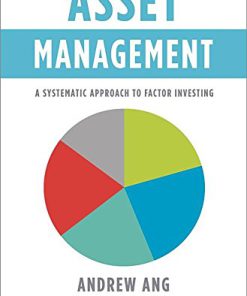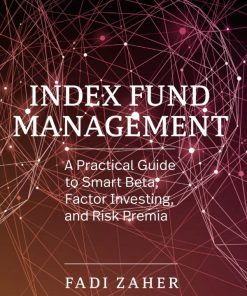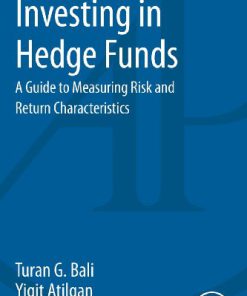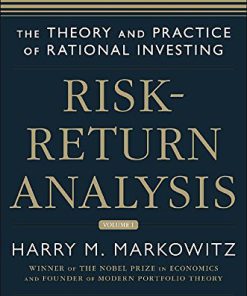Risk Based and Factor Investing 1st Edition by Emmanuel Jurczenko ISBN 1785480081 9781785480089
$50.00 Original price was: $50.00.$25.00Current price is: $25.00.
Risk Based and Factor Investing 1st Edition by Emmanuel Jurczenko – Ebook PDF Instant Download/Delivery: 1785480081, 978-1785480089
Full download Risk Based and Factor Investing 1st Edition after payment

Product details:
ISBN 10: 1785480081
ISBN 13: 978-1785480089
Author: Emmanuel Jurczenko
This book is a compilation of recent articles written by leading academics and practitioners in the area of risk-based and factor investing (RBFI).
The articles are intended to introduce readers to some of the latest, cutting edge research encountered by academics and professionals dealing with RBFI solutions. Together the authors detail both alternative non-return based portfolio construction techniques and investing style risk premia strategies.
Each chapter deals with new methods of building strategic and tactical risk-based portfolios, constructing and combining systematic factor strategies and assessing the related rules-based investment performances. This book can assist portfolio managers, asset owners, consultants, academics and students who wish to further their understanding of the science and art of risk-based and factor investing.
- Contains up-to-date research from the areas of RBFI
- Features contributions from leading academics and practitioners in this field
- Features discussions of new methods of building strategic and tactical risk-based portfolios for practitioners, academics and students
Risk Based and Factor Investing 1st Table of contents:
1: Advances in Portfolio Risk Control
- Abstract
- 1.1 Introduction
- 1.2 The empirical example and preliminaries
- 1.3 Maximum Sharpe ratio portfolio (MSRP)
- 1.4 1/N or equal-weighting
- 1.5 Minimum variance portfolio (MVP)
- 1.6 Maximum diversification portfolio (MDP)
- 1.7 Equal risk contribution portfolio (ERCP): full risk parity
- 1.8 Inverse volatility portfolio (IVP): naive risk parity
- 1.9 Volatility weighting over time
- 1.10 Evaluation
- 1.11 Appendix
2: Smart Beta: Managing Diversification of Minimum Variance Portfolios
- Abstract
- 2.1 Introduction
- 2.2 Risk-based investing and variance minimization
- 2.3 Managing the diversification
- 2.4 Understanding the behavior of smart beta portfolios
- 2.5 Conclusion
- 2.6 Appendix
3: Trend-Following, Risk-Parity and the Influence of Correlations
- Abstract
- 3.1 Introduction
- 3.2 Methodology
- 3.3 Data description
- 3.4 Performance evaluation of trend-following
- 3.5 Risk-parity principles
- 3.6 Performance evaluation of risk-parity trend-following
- 3.7 Conclusion
- 3.8 Appendix: solving for risk parity
4: Diversifying Risk Parity: In Today, Out Tomorrow?
- Abstract
- 4.1 Managing diversification
- 4.2 Rationalizing principal portfolios
- 4.3 Risk-based asset allocation
- 4.4 Conclusion
- 4.5 Acknowledgments
5: Robust Portfolio Allocation with Systematic Risk Contribution Restrictions
- Abstract
- 5.1 Introduction
- 5.2 Portfolio allocation with risk contribution restrictions
- 5.3 Portfolio allocation with systematic risk contribution restrictions
- 5.4 Illustrations with different risk measures
- 5.5 Application
- 5.6 Concluding remarks
6: Risk-Based Investing but What Risk(s)?
- Abstract
- 6.1 Introduction
- 6.2 Expected shortfall as risk measure
- 6.3 Broadening risk measures
- 6.4 Empirical results
- 6.5 Conclusion
- 6.6 Mathematical Appendix
- 6.7 Data Appendix
7: Target Volatility
- Abstract
- 7.1 Introduction
- 7.2 Better leverage and the Samuelson puzzle
- 7.3 Target volatility and Sharpe ratio improvement
- 7.4 Informative or uninformative leverage
- 7.5 Target volatility and tail hedging
- 7.6 Asymmetric leverage
- 7.7 Target volatility across asset classes
- 7.8 Conclusions
8: Smart Beta Equity Investing Through Calm and Storm
- Abstract
- 8.1 Introduction
- 8.2 A regime switching approach to market timing
- 8.3 Sample and variable description
- 8.4 Results
- 8.5 Conclusion
- 8.6 Acknowledgments
- 8.7 Appendix
9: Solving the Rebalancing Premium Puzzle
- Abstract
- 9.1 Introduction
- 9.2 Rebalancing as a risk premium
- 9.3 Probing the limits: when simulations provide more insight
- 9.4 Beating the best asset: a path to the low-risk anomaly explanation
- 9.5 When rebalancing pays off
- 9.6 Conclusions
- 9.7 Appendix
10: Smart Betas: Theory and Construction
- Abstract
- 10.1 Introduction
- 10.2 Signals
- 10.3 Fundamental law of active management
- 10.4 Factors construction
- 10.5 Conclusions
11: Low-Risk Anomaly Everywhere: Evidence from Equity Sectors
- Abstract
- 11.1 Introduction
- 11.2 Low volatility or low beta?
- 11.3 Sector-neutral low-risk investing
- 11.4 Sector-neutral versus non-sector neutral low-risk investing
- 11.5 Conclusions
- 11.6 Acknowledgments
12: The Low Volatility Anomaly and the Preference for Gambling
- Abstract
- 12.1 Introduction
- 12.2 A brief review of the literature
- 12.3 Lottery and volatility double sort
- 12.4 International evidence
- 12.5 Conclusion
- 12.6 Appendix
13: The Low Beta Anomaly and Interest Rates
- Abstract
- 13.1 Literature review
- 13.2 The anomaly and interest rates
- 13.3 Model specification
- 13.4 Empirical analysis and results
- 13.5 The anomaly and interest maturity mismatch
- 13.6 Model specification
- 13.7 Results
- 13.8 Concluding remarks
14: Factoring Profitability
- Abstract
- 14.1 Quality is an active investment strategy with a long and distinguished history
- 14.2 Replicating gross profitability with style factors
- 14.3 The four-factor Fama–French–Carhart model does not explain gross profitability
- 14.4 The Barra USE4 model explains a substantial portion of gross profitability over the past two decades
- 14.5 Conclusion
- 14.6 Disclosure
15: Deploying Multi-Factor Index Allocations in Institutional Portfolios
- Abstract
- 15.1 Introduction
- 15.2 Implementing factors through multi-factor index allocations
- 15.3 Selecting the right blend of factors
- 15.4 Implementation considerations
- 15.5 Multi-factor index allocations: examples
- 15.6 Conclusion
16: Defining the Equity Premium, a Framework
- Abstract
- 16.1 Introduction
- 16.2 Defining the equity premium
- 16.3 Risk-rewards homogeneity and the equity premium
- 16.4 A taxonomy of smart beta and risk factors driven strategies
- 16.5 Being practical: a core-satellite portfolio allocation
- 16.6 Conclusion
17: Designing Multi-Factor Equity Portfolios
- Abstract
- 17.1 Introduction
- 17.2 Absolute return perspective
- 17.3 Relative risk perspective
- 17.4 Conclusion: index design and allocation decisions for multi-factor equity portfolios
18: Factor Investing and Portfolio Construction Techniques
- Abstract
- 18.1 Introduction
- 18.2 Risk factor investing: the new paradigm
- 18.3 Theory meets practice
- 18.4 Taxonomy of risk premia strategies
- 18.5 Is risk premia allocation inherently superior to asset-class allocation?
- 18.6 Portfolio construction techniques
- 18.7 An alternative approach for defining diversification
- 18.8 An alternative definition of risk
- 18.9 Comparison of different risk-based portfolio construction techniques
- 18.10 Conclusion
19: Multi-Factor Portfolio Construction for Passively Managed Factor Portfolios
- Abstract
- 19.1 A short history of passively managed factor portfolios
- 19.2 Single-factor portfolio construction
- 19.3 Why combine multiple factors?
- 19.4 Multi-factor portfolio construction
- 19.5 Conclusion
- 19.6 Appendix A: description of tilted factor portfolios
20: Statistical Overfitting and Backtest Performance
- Abstract
- 20.1 Introduction
- 20.2 Backtest overfitting in finance and investments
- 20.3 Quantifying backtest overfitting effects
- 20.4 An online demonstration of backtest overfitting
- 20.5 Conclusion
- 20.6 Acknowledgments
People also search for Risk Based and Factor Investing 1st :
evidence based risk factors and maram risk
risk based capital factors
what is a risk based approach
risk management factor considerations that apply to all cft events
evidence based hamstring injury prevention and risk factor management
Tags:
Emmanuel Jurczenko,Risk Based,Factor,Investing 1st
You may also like…
Business & Economics - Management & Leadership Business & Economics - Investing
Asset Management A Systematic Approach to Factor Investing 1st Edition Andrew Ang
Computers - Security
The Forrester WaveTM Risk Based Authentication Q2 2020 1st Edition Andras Cser
Business & Economics - Markets
Index Fund Management: A Practical Guide to Smart Beta, Factor Investing, and Risk Premia Fadi Zaher
Business & Economics
Business & Economics
Business & Economics - Investing
Equity Smart Beta and Factor Investing for Practitioners Khalid Ghayur 1119583446 9781119583448
Business & Economics
Business & Economics












